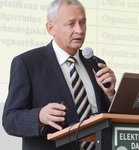“1.25: Research on development of mathematical model for silicon crystal growing technological process by using image processing methods.”- SikA
1. Title and aim
Czochralski silicon growing method is based on silicon melting, which is achieved either by heating the crucible with a powerful heating element or using the electron beam gun which heats and melts silicon.
Electron beam gun ensures a lower energy consumption of one silicon ingot creation, but such processes are required to develop their own mathematical model to establish as accurately as possible ingot. From the formed ingot of accuracy depends on how much material will be mechanically separated from the ingot to create a cylinder. The more accurate grown silicon crystal ingot, less material will go to waste, and hence the electricity will be spent.
The project aims to explore importance of the silicon crystal growing process mathematical model modifiable parameters and stability of the crystal diameter, using an image processing technique by measuring the diameter of the silicon crystal and the electron beam gun power.
2. Development and earlier history of research.
A similar study was carried out before the beginning of the project in EDI cooperation with Ltd. “KEPP EU”, the aim of which was to find out or using a video camera, it is possible to measure the crystal meniscus diameter and from those data, make control of the process.
3. How to ongoing research
– Used technology
Silicon crystals are grown by Czochralski similar practices.
The experimental apparatus consists of melting and towing chambers separated by valves, two electron guns equipped with individual power supplies, as well as crystal pulling mechanism. The cultivation process begins dipping crystal “seed” in the molten silicon mass, which is then rotated and pulled upwards. Crucible with the melted material during the process remains static. Melting process provides two electron beam guns which heat the material moving along the rays of circular trajectory around the crystal.
The process is filmed with the IP camera and the data is sent to a computer, where they are analyzed. Established image processing software analyzes the video stream data and performs crystal meniscus region segmentation and range measurement. Using the measured radius, it is carried out ripping speed adjustment in direct proportion to affect the grown silicon crystal diameter.
– Equipment
– It uses in systems that allow the crystals to grow by the above method.
4. Results achieved.
Currently has designed silicon crystal growing process mathematical model, based on the established image processing algorithm performing silicon crystal ingot diameter measurement. The main objective of mathematical model is to adjust crystal ripping speed to make it possible more regular crystal diameter.
5. Analogues in the world and its competitiveness.
In the world there is a similar approach to the silicon crystal growth, based on crucible heating, where most of the used energy is consumed in useless heat. But with electron beam gun all the radiated energy is transmitted to the silicon mass, from which the crystal is pulled.
6. Practical application in the future and commercial potential.
The project results will be used for the production of higher quality silicon crystals, providing greater export capacity. Providing the silicon crystal growing services through customer inputs, the optimal estimated service price is 30 EUR / kilo. Export market covers China, Taiwan, Denmark, Russia, etc. countries. Estimated demand is around 40 tons per year.
7. Cooperation partners
The study is conducted in cooperation with Ltd. „KEPP EU”, which is the managing partner of this research.
8. Cooperation with universities, students, etc.
Project is developed by scientific staffs, who are also the Latvian University and Riga Technical University students.
9 Photo, video
https://www.youtube.com/watch?v=-HOTtb6l3J8
